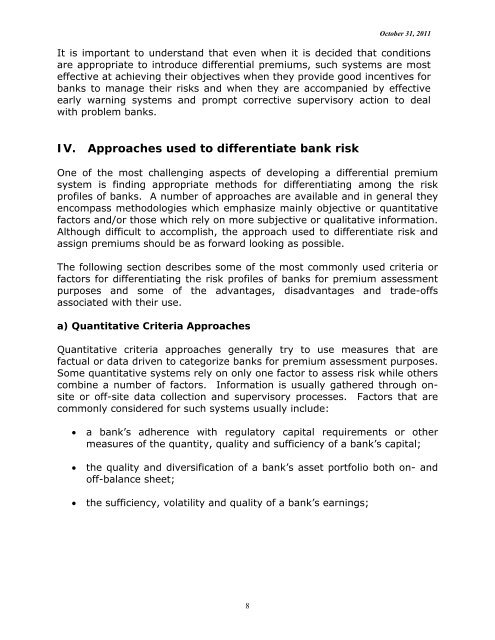General Guidance for Developing Differential Premium Systems
General Guidance for Developing Differential Premium Systems
General Guidance for Developing Differential Premium Systems
Create successful ePaper yourself
Turn your PDF publications into a flip-book with our unique Google optimized e-Paper software.
October 31, 2011<br />
It is important to understand that even when it is decided that conditions<br />
are appropriate to introduce differential premiums, such systems are most<br />
effective at achieving their objectives when they provide good incentives <strong>for</strong><br />
banks to manage their risks and when they are accompanied by effective<br />
early warning systems and prompt corrective supervisory action to deal<br />
with problem banks.<br />
IV. Approaches used to differentiate bank risk<br />
One of the most challenging aspects of developing a differential premium<br />
system is finding appropriate methods <strong>for</strong> differentiating among the risk<br />
profiles of banks. A number of approaches are available and in general they<br />
encompass methodologies which emphasize mainly objective or quantitative<br />
factors and/or those which rely on more subjective or qualitative in<strong>for</strong>mation.<br />
Although difficult to accomplish, the approach used to differentiate risk and<br />
assign premiums should be as <strong>for</strong>ward looking as possible.<br />
The following section describes some of the most commonly used criteria or<br />
factors <strong>for</strong> differentiating the risk profiles of banks <strong>for</strong> premium assessment<br />
purposes and some of the advantages, disadvantages and trade-offs<br />
associated with their use.<br />
a) Quantitative Criteria Approaches<br />
Quantitative criteria approaches generally try to use measures that are<br />
factual or data driven to categorize banks <strong>for</strong> premium assessment purposes.<br />
Some quantitative systems rely on only one factor to assess risk while others<br />
combine a number of factors. In<strong>for</strong>mation is usually gathered through onsite<br />
or off-site data collection and supervisory processes. Factors that are<br />
commonly considered <strong>for</strong> such systems usually include:<br />
<br />
<br />
<br />
a bank’s adherence with regulatory capital requirements or other<br />
measures of the quantity, quality and sufficiency of a bank’s capital;<br />
the quality and diversification of a bank’s asset portfolio both on- and<br />
off-balance sheet;<br />
the sufficiency, volatility and quality of a bank’s earnings;<br />
8

















